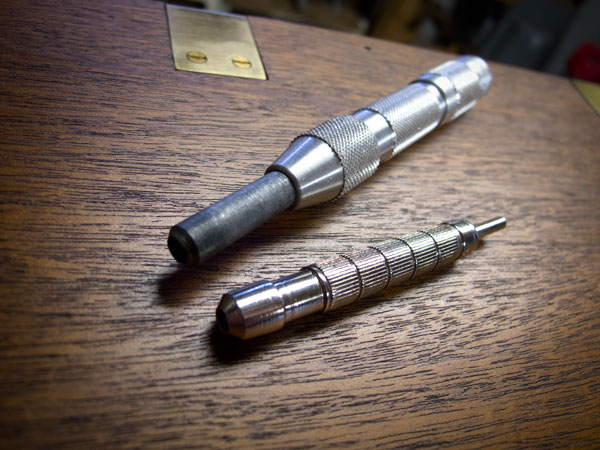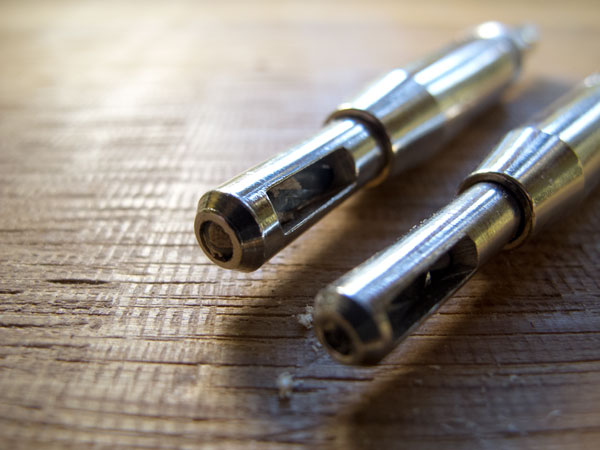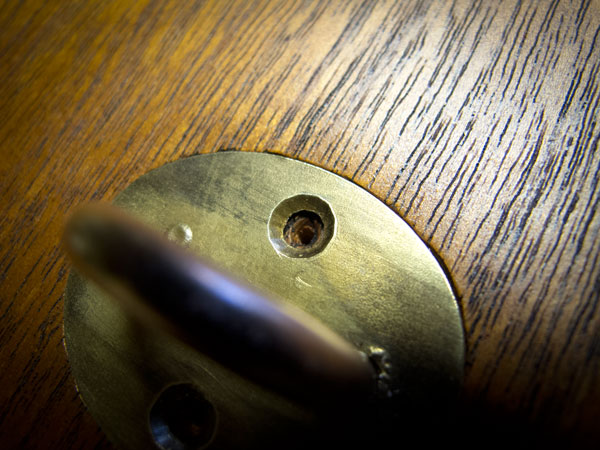We may receive a commission when you use our affiliate links. However, this does not impact our recommendations.
Thanks to a book I’m writing on campaign furniture, I’ve installed more brass hardware in the last two years than in my first 18 years of woodworking.
As a result, I have become quite particular about how I install screws for hinges, pulls, corner protectors, hasps, locksets and so on. I’ve revisited a lot of old techniques and tried a lot of different ways of getting brass screws seated perfectly vertical without shifting the hardware in the slightest.
If your hardware shifts, that’s a significant problem with campaign furniture because most of the hardware is installed in shallow recesses. If the hardware moves a fraction of a millimeter, the remainder of the brass might not seat in its mortise.
It is a lot like installing 70 or so hinges in an afternoon.
Now, if you are satisfied with the way you install your hardware, stop reading right now. I’m not trying to change anyone’s mind about how they install hardware – I’m just trying to present an alternative to the way I was first taught to install brass.
And that technique? Vix bits (shown above). Sometimes called “self-centering hinge bits.” I know many professionals live by these bits, but I’ve never liked them. I think the spring in the bit is too stiff, and the drill bits are liable to snap when you press the drill down to plunge. (Yes, I’ve tried several brands.)
I prefer a more manual process. It’s slower, but it gives me more control.
The most important tool is a spring-loaded hinge center punch. I’ve tried two brands: the Stanley and the Starrett No. 819. I vastly prefer the Starrett because it works with only one hand. You can hold the hardware right where you want it and then press the Starrett into the countersink and get it perfectly vertical with the other. You press the center punch down, loading the spring. Then the spring fires, punching the hole for your screw.
The Stanley looks like the Starrett, but it doesn’t “fire” the punch. So it’s a two-handed tool. One hand to hold the punch and the other to hit the plunger with a little hammer (yes, I know you can use finger pressure alone, but it doesn’t work for crap in hard woods).
After punching the centered hole, I drill the pilot hole with an eggbeater drill. This old drill (a $10 eBay find), allows me to control the exact depth of the hole and to gently increase the diameter a tad if need be.
To install the screw I rub the threads with paraffin and drive the screw with a screwdriver with a ground tip – like the ones that gunsmiths use. I like the Grace USA drivers, which I have written about before, but you can make your own on the grinder – or buy ground bits from a gun store, such as Brownell’s.
— Christopher Schwarz
Here are some supplies and tools we find essential in our everyday work around the shop. We may receive a commission from sales referred by our links; however, we have carefully selected these products for their usefulness and quality.











I have the Stanley and have tried it on several occasions but been unhappy with the results. I feel I do as well hitting the centre of the hole by eye with my awl.
The example I own has a long taper on the point that leaves the first 1/2 inch of the shaft unsupported. That seems to be enough to allow the point to wander off centre. I don’t know if it is the growth rings or my striking it slightly off centre. I would say 25% of the time it is visibly wrong when I remove the punch.
Am I doing something wrong?
you can also find this type punch at enco and other metal tool sites a lot cheaper than a starrett that is just as good
I love the idea of the Starrett #819 spring loaded punch, it never occurred to me there was something better than the spring loaded centering punch you tap with a hammer.
One other note: Brass screws are always so soft and tend to create a splinter of brass when the screwdriver slips out of the slot, just as you are lining up the slot with all the other screws. We leaned to use a steel screw first to cut the thread and then just before finishing replace the steel screws with brass screws. These days the challenge is getting steel and brass screws that match! Cheers
Sweet!! I’ve always wondered how to perfectly center a hole in a hinge. Now I know. Thanks Chris!
If you click on the Starrett 819 link it will take you to a product page. On the product page click on the Downloads tab. The last item on the list is a video showing how to use the self-centering punch. It is a simple, straightforward tool. Chris, thanks for letting us know the punch actually gets the job done.
I agree with the above comments and have had problems with “shifting” and once that happens it’s like spending a weekend in Cabin In the Woods. Ordered the Starrett from Amazon.
Excellent information! I’m still trying ut correctly use a set of vix bits I acquired in 1978. They usually work quite well, but yes, they do cause errors. Do you use a tapered bit in the drill to increase the hole to the correct depth?
I struggled with Vix bits in new-growth wood with wide growth rings. Bits will follow a hard grain line into the softer wood in between the growth rings. Result – an off-center or crooked hole. I’ll put the Starrett No 819 on my ‘things to try’ list. You mentioned the Starrett working in hardwoods. Have you tried it in softer woods?
Can you please post a small video using the tool?
Tks